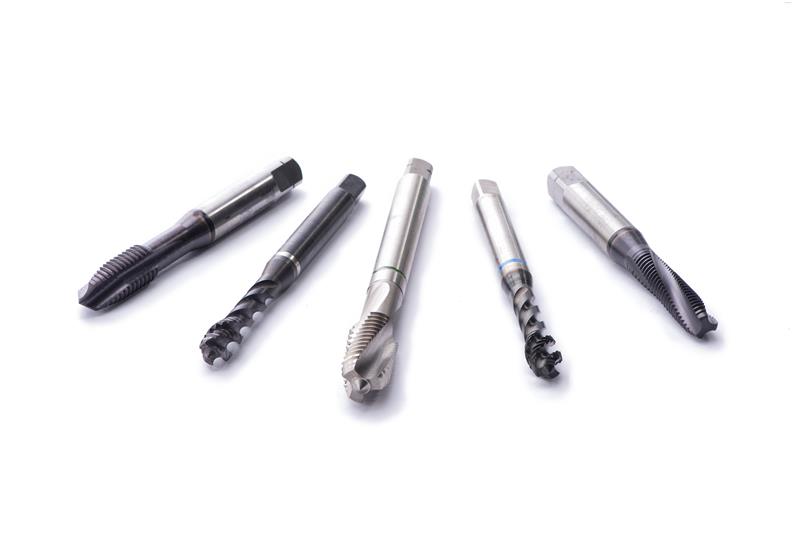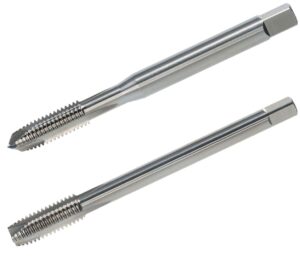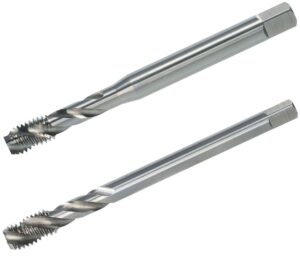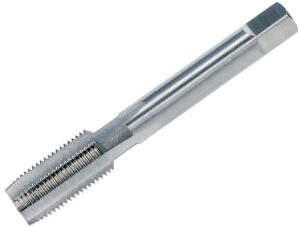
Machine Taps Comparison: Spiral Flute vs Spiral Point vs Straight Flute
When a tap breaks during the final operations of a complex machined part, it’s more than just frustrating—it’s costly. Your production stops, your schedule slips, and in worst cases, an expensive workpiece becomes scrap. The difference between choosing the right tap versus the wrong one directly impacts your shop’s efficiency, product quality, and profitability.
While many factors influence tap performance—material, coolant, coatings, and more—one fundamental decision is selecting the correct tap design. In this comprehensive guide, we’ll compare four essential machine tap styles:
- Spiral Point Taps (Gun Taps)
- Spiral Flute Taps
- Straight Flute Taps
Understanding the unique characteristics of each design will help you make informed decisions, reduce downtime, and maximize your operation’s productivity.
Understanding Chip Flow: The Foundation of Successful Tapping
Before diving into specific tap designs, it’s crucial to understand that successful tapping depends primarily on effective chip management. The leading cause of tap failure is improper chip evacuation [3], which can result in:
- Chip packing and clogging
- Excessive torque requirements
- Poor thread finish
- Premature tool wear
- Catastrophic tap breakage
Each tap design handles chips differently, which is the key to selecting the right tool for your application [4].
The 3 Main Types of Cut Taps
Let’s look at the three most common cut taps:
| Types of Cut Taps | Descriptions |
| Spiral Point |
|
| Spiral Flute |
|
| Straight Flute |
|
Blind Holes vs. Through Holes
When tapping a blind hole — a hole that stops before breaking through — chip evacuation becomes critical.
A Spiral Point Tap forces chips downward. If those chips have nowhere to go, they pack up at the bottom, causing pressure that can chip or break the tap.
That’s why blind holes typically require a Spiral Flute Tap, which lifts chips out of the hole.
On the other hand, through holes are ideal for Spiral Point Taps since chips can safely exit through the bottom.
Material type also plays a role:
- Ductile materials (like mild steel or aluminum) create long, stringy chips — these must be cleared efficiently
- Brittle materials (like cast iron) form short, crumbly chips — straight flute taps handle these best
Premium Quality Cutting Tools at Competitive Prices
Our cutting tools are expertly manufactured and rigorously tested to enhance machining performance and operational savings.

1. Spiral Point Taps (Gun Taps)

Design Features
Spiral Point taps have straight flutes along the body but feature a specialized cutting face design at the tap point. The first few threads have cutting faces ground at an angle to the tap axis, creating a spiral or “gun” shaped point while maintaining straight flutes along the body [5].
How They Work
The angled cutting faces act like a screw, forcing chips forward through the hole rather than collecting them in the flutes. This “pushing” action propels chips ahead of the tap and out through the bottom of through holes.
When to Choose Spiral Point Taps
- Through Holes: The defining application for Spiral Point taps. Chips are pushed ahead and out the bottom of the hole.
- High-Volume Production: Their stronger design and efficient chip evacuation make them excellent for production environments.[4]
- CNC Machining: Automated operations benefit from the reliability and reduced cycle times.[4]
- Higher Speed Requirements: Can typically be run 30-40% faster than conventional taps.[4]
- Limited Power Situations: Requires less torque to drive, making them suitable for machines with power limitations.[4]
Advantages
- Superior strength due to larger cross-sectional area
- Requires less torque and power to drive
- Can be run at higher speality
- Reduced risk of chip clogging in through holes
- Better lubrication delivery to cutting edges
- Lower tendency to deflect during cutting
Limitations
- Not suitable for blind holes (chips have nowhere to go)
- Requires the tap to exit the hole completely
- Less effective in very thin materials
- Not ideal when the tap cannot pass entirely through the workpiece
2. Spiral Flute Taps

Design Features
Spiral Flute taps feature helical flutes that wrap around the tap body, similar to a twist drill bit. These spiral channels create pathways for chips to evacuate upward, away from the cutting action. The angle of the spiral (helix angle) can vary depending on the specific application and material being tapped [6].
How They Work
When a Spiral Flute tap cuts threads, the chips form and follow the spiral flutes upward and out of the hole—in the opposite direction of the tap’s forward movement. This “pulling” action is particularly valuable in blind holes, where chips have nowhere else to go [4].
When to Choose Spiral Flute Taps
- Blind Holes: The primary application for Spiral Flute taps. The helical flutes pull chips up and out of the hole, preventing chip packing at the bottom.
- Ductile Materials: Materials that produce long, stringy chips (like aluminum, copper, mild steel) benefit from the chip evacuation properties of spiral flutes.[4]
- Bridging Gaps: When tapping holes with interruptions like keyways, cross-holes, or other features that might trap chips.[4]
- Deep Holes: As hole depth increases, chip evacuation becomes more critical, making spiral flutes advantageous.[4]
- Bottom Tapping: When threads must extend close to the bottom of a blind hole.[4]
Premium Quality Cutting Tools at Competitive Prices
Our cutting tools are expertly manufactured and rigorously tested to enhance machining performance and operational savings.

Material-Specific Helix Angle Selection
The helix angle of a tap’s spiral flutes plays a major role in how it performs across different materials. As a general rule: the softer and more ductile the material, the higher the helix angle should be.[1]
A high helix angle helps lift long, stringy chips up and out of the hole for easier evacuation.
In contrast, harder or brittle materials work better with lower helix angles, since these materials tend to break into small fragments rather than forming continuous chips.
If the helix angle is too steep for a hard material, those brittle chips can crumble, fall back into the hole, and cause issues — such as torn threads during reversal or even a broken tap.
| Angle | Best For |
| High Spiral Flutes (45°+) | Very ductile materials like aluminum and copper |
| Medium Spiral Flutes (38° – 42°) | Medium to high carbon steels, free machining stainless steels |
| Moderate Spiral Flutes (25° – 35°) | Free machining low or leaded steels, some bronze or brass |
| Slow Spiral Flutes (5° – 20°) | Tougher materials like stainless steel, titanium, or high nickel alloys |
Advantages
- Superior chip evacuation in blind holes
- Prevents chip packing at the hole bottom
- Bridges interruptions in the hole wall
- Excellent for long-chip materials
- Reduces cutting forces in many applications
Limitations
- Reduced cross-sectional area decreases tap strength
- Generally should be run at lower speeds (25-30% slower than standard taps)
- More expensive than basic tap designs
- May affect thread accuracy in some applications
3. Straight Flute Taps

Design Features
Straight Flute taps feature traditional, parallel flutes that run straight along the tap’s axis. They typically have 2-4 flutes evenly distributed around the tap’s circumference. This is the “standard” tap design that has been used for generations.[6]
How They Work
As the tap rotates and advances into the hole, material is cut away and collects in the straight flutes. The chips accumulate in these channels and must be periodically cleared by reversing the tap or flushing with coolant. In through holes, chips can sometimes pass through the hole, but there’s no specific mechanism to direct them.[6]
When to Choose Straight Flute Taps
- Short-Chipping Materials: Materials like cast iron and brass that produce small, brittle chips work well with straight flute taps.[2]
- Through Holes of Limited Depth: When hole depth doesn’t exceed 1-1.5 times the diameter, straight flutes can be adequate for through holes.[6]
- General-Purpose Applications: When a versatile tap is needed for various non-critical applications.[6]
- Hand Tapping Operations: The simplicity of straight flutes makes them suitable for manual tapping.[6]
- Cost-Sensitive Applications: When the lowest cost tap is required for simple applications.[6]
Advantages
- Strongest cross-sectional design of all tap types
- Simplest and most economical tap style
- Good thread accuracy and finish in appropriate applications
- Versatile for both machine and hand tapping
- Available in the widest range of sizes and thread forms
Limitations
- Poor chip evacuation in blind holes
- Limited chip storage capacity in the flutes
- Risk of chip packing in deeper holes
- Not ideal for ductile materials that produce long chips
- Typically requires frequent backing out to clear chips in deeper holes
Premium Quality Cutting Tools at Competitive Prices
Our cutting tools are expertly manufactured and rigorously tested to enhance machining performance and operational savings.

Best Practices for Optimal Results
| Category | Recommendation | Notes |
| Hole Type |
|
Match tap to hole geometry |
| Material |
|
Adjust helix angle for chip control |
| Speed |
|
Based on material & hole type |
| Lubrication |
|
Coolant concentration affects tap life |
| Hole Sizing |
|
Correct size = cleaner threads |
Troubleshooting Common Tapping Problems
| Problem | Possible Cause | Solution |
| Broken tap in blind hole | Chip packing at hole bottom | Switch to spiral flute tap with appropriately helix angle |
| Excessive torque | Poor chip evacuation | Use spiral point for through holes or proper helix angle spiral flute for blind holes |
| Poor thread finish | Incorrect tap for material | Match tap style to material |
| Tap deflection | Insufficient strength | Consider straight flute for maximum rigidity or spiral point when appropriate |
| Build-up edge on tap | Material adhesion to cutting edges | Use spiral flute in ductile materials with proper lubricant |
| Inconsistent thread quality | Wrong tap for application | Follow application selection guide for best results |
Making the Right Choice for Your Bottom Line
Choosing the right tap design isn’t just a technical decision. It’s a business decision that affects your productivity and profitability.[1] Understanding the unique advantages of Spiral Point, Spiral Flute, and Straight Flute allows you to optimize your threading operations for specific applications.
Remember these key principles:
- For through holes, Spiral Point taps offer the best combination of speed and quality [4]
- For blind holes, Spiral Flute taps provide superior chip evacuation and reliability [4]
- For precision threading and harder materials, Straight Flute taps offer strength and accuracy [7]
By selecting the appropriate tap for your specific application, you’ll achieve better thread quality, longer tool life, reduced power consumption, and ultimately, more cost-effective machining operations. The time you spend making the right choice now will pay dividends in reduced downtime, fewer broken taps, and higher quality threaded features.
Remember: The difference between a profitable job and a costly mistake often comes down to choosing the right tool for the task at hand.
FAQ
1. Why not use one tap for everything?
Each tap type manages chips differently, a crucial factor for successful threading. Using a spiral point tap in a blind hole can cause chip packing and breakage, while a straight flute tap in ductile material may lead to high torque and poor thread quality.
The small investment in specialized taps saves far more by reducing tool breakage, scrap, and downtime.
2. What are the differences between drilling and tapping?
Drilling and tapping are distinct operations that serve different purposes in the machining process:
Drilling
- Creates a smooth cylindrical hole without threads
- Uses a cutting tool with two or more flutes that remove material to form a hole
- The hole diameter is determined by the drill size
- Generally requires less torque and can be performed at higher speeds
- Usually precedes tapping when internal threads are needed
Tapping
- Creates internal threads inside a pre-drilled hole
- Uses a specialized cutting tool (tap) with precise thread geometry
- Requires a specific pre-drilled hole size (typically 75-85% of the thread’s major diameter, depending on material)
- Generally requires more torque and must be performed at calculated speeds based on material and tap design
- Involves both cutting and forming operations as the tap creates the thread profile
3. How many types of threading taps are there?
While this article focuses on the four main machine tap designs (Spiral Point, Spiral Flute, Straight Flute), there are actually several more categories and specialized types of threading taps available for different applications:
- Hand Taps
- Machine Taps
- Threading Dies
- Forming Taps
Each of these tap types serves specific applications and threading standards, further emphasizing the importance of selecting the right tool for the job.
References
[1] Tapping 101: Spiral Flute vs. Spiral Pointed Taps [Internet]. Browne & Co. 2025 [cited 2025 Oct 7]. Available from: https://www.brownesales.com/news/tapping-101-spiral-flute-vs-spiral-pointed-taps
[2] Tool T. Picking the Right Tap in Metalworking | Triumph Tool Ltd. [Internet]. TriumphTool. 2017. Available from: https://www.triumphtool.com/metal-working-tools-blog/picking-the-right-tap-in-metalworking/
[3] What is the difference between a spiral point and spiral flute tap? – DC Swiss [Internet]. DC Swiss. 2019 [cited 2025 Oct 7]. Available from: https://www.dcswiss.co.uk/faqs/nullam-quis-tempus-velit-vivamus-venenatis-felis-a-mattis-accumsan/
[4] Cutwel. Spiral Point Taps vs Spiral Flute Taps: Understand The Difference [Internet]. Cutwel.co.uk. 2025 [cited 2025 Oct 7]. Available from: https://www.cutwel.co.uk/blog/spiral-point-taps-vs-spiral-flute-taps
[5] Spiral Flute vs. Spiral Point vs. Forming Taps – Which is Right for You? [Internet]. Optimax Tools. 2025 [cited 2025 Oct 7]. Available from: https://optimax.tools/spiral-flute-vs-spiral-point-vs-forming-taps-which-is-right-for-you/
[6] Different Types of Thread Taps [Internet]. Epic Tool. 2020 [cited 2025 Oct 7]. Available from: https://epictool.ca/different-types-of-thread-taps/
[7] Straight Flute vs. Spiral Flute Taps: Choosing the Right One [Internet]. Jarvis Cutting Tools. 2025 [cited 2025 Oct 7]. Available from: https://www.jarviscuttingtools.com/news/straight-flute-vs-spiral-flute-taps
Acquire Premium Quality Cutting Tools at Exceptional Prices with Kota Cutting Tools
Our cutting tools are expertly manufactured and rigorously tested by our technical team to enhance your machining performance and take your business to new heights.